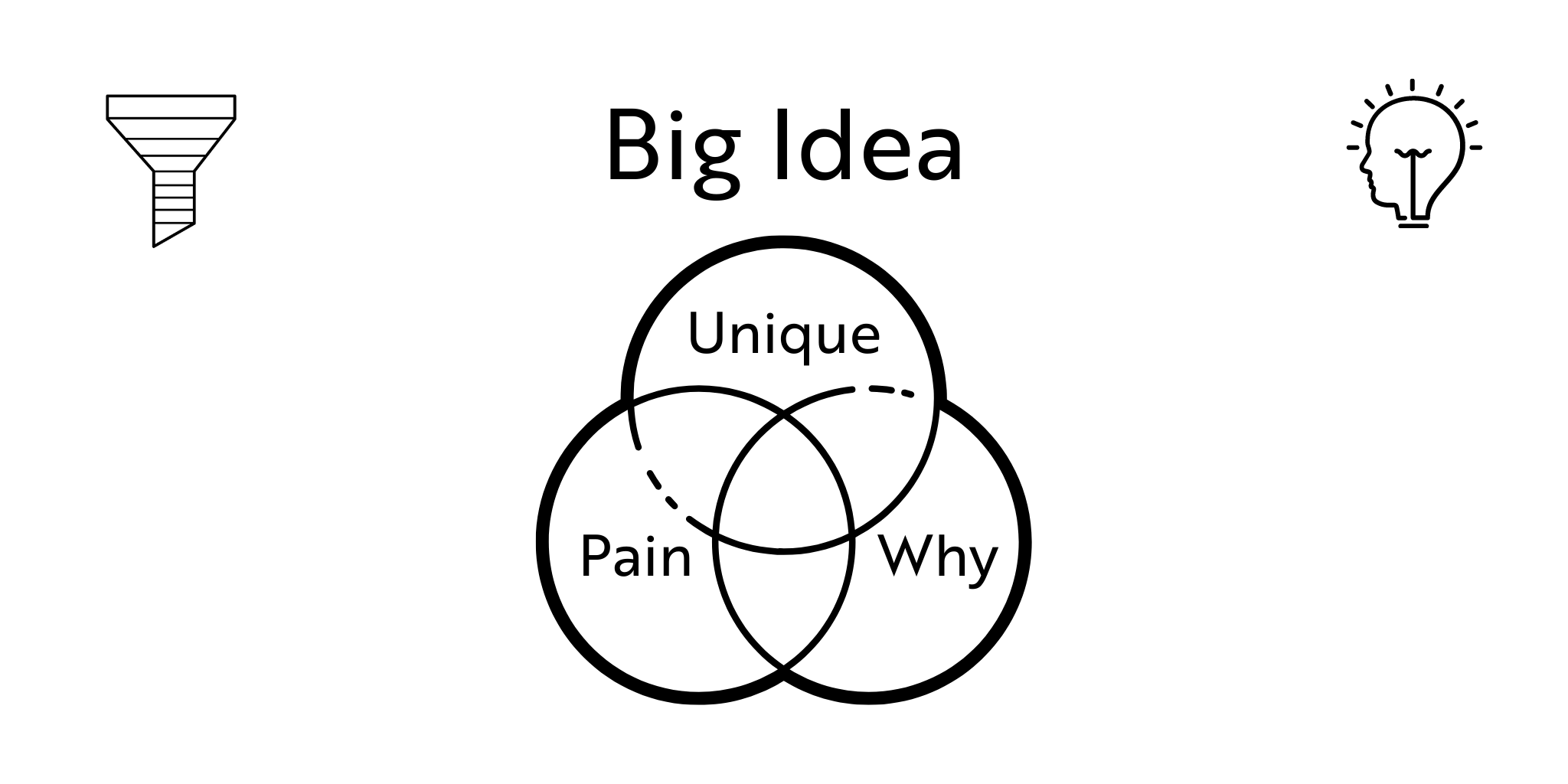What's Your Big Idea?
The big idea is your brand's north star. Without one, you will be lost in the sea of noise.

When Ravi was a VC in India, he wanted to invest in big ideas and technologies that would solve big problems. The one he latched onto was water.
Water is essential for life. Without it, most life on earth would not exist. Dirty water accounts for countless millions upon millions of deaths worldwide. If you can fix the water, you can save lives.
This mantra drove his investment thesis to the point where he would see technology after technology to clean water. The opportunities were endless or were they.
It turns out that fixing water, especially with technology in countries that lack infrastructure, is more than just some fancy-dancy reverse osmosis filter or <insert cool technology here>. It turns out that you don’t need fancy technology to create clean drinking water. All you need to do is simply drop a one penny tablet in a jug and call it done. The problem with fixing water is not treating it, it turns out it’s testing it.
The idea that testing the water that people drink is more important than treating it is the essence of a big idea simply because the true goal of clean and safe water is not necessarily cleaning it up but figuring out how it’s getting dirty in the first place.
Of course, cleaning the water is important but it’s downstream from the realization of the source of the problem. That Big Idea is what drives Sutro.
What’s the Big Idea?
There are a lot of people that talk about the concept of a Big Idea. For our purposes, we’re going to use the definition in the book What’s the Big Idea? In the book, Leslie Watts and Shelley Sperry dissect the pieces and parts of a Big Idea Nonfiction book. The power of dissection is that it makes a subjective topic, that of what makes a nonfiction book work, and makes it objective -- which is our goal here.
To ground us on the concept of the Big Idea, we’re going to take Leslie and Shelly’s definition and apply it to our Story Funnel since a Big Idea Nonfiction book is the best framework for telling a brands story.
A Venn Diagram of Narrative, Academic, and How-To
There are three types of nonfiction books that make up a Big Idea Book -- Narrative, Academic, and How-To. The Venn Diagram of these three types is what forms the core of a Big Idea book and frankly also forms the Big Idea we’re talking about.
These three types also mirror closely the Pathos (Narrative), Ethos (Academic), and Logos (How-To) of the modes of persuasion that we’ll also be using. In essence, a good Big Idea Nonfiction book has similar pieces and parts to a good Big Idea for a brand or company. As we touched on briefly before in the last chapter about Core Values, you’ll start to see why brands like Nike, Apple, BMW, etc. have such a strong brand awareness and how their Big Ideas drive that awareness but before we get to that, we’re going to need to do some work.
Ideas Are Worthless ...
It’s the execution of an idea that matters. So when we talk about what your Big Idea is, we want it to be describing what you’re currently doing will lead to your vision of the world. This is also a good way to look at brands you want to compare yourself too as well.
Of course, the path to your big idea will zig and zag but it should be grounded in what you are currently executing on. If you’re currently not building anything or want to use this framework on a new idea, it will still work but you’ll have to be a little more creative on your answers.
In the case of Sutro, the Big Idea is to fix water by testing it so that we know what makes it dirty and we’re starting with swimming pools. It’s a simple idea that is clear, concise, and compelling -- the hallmarks of a Big, Big Idea.
Four Steps to Figuring Out Your Big Idea
In order to sharpen your message and keep it clear, concise, and compelling across all your communications, we’ll take you through a simple four-step process to great your brand’s big idea. This statement of 1-2 sentences that should take less than 10 seconds to say, will be the tip of your communications spear. It’s your North Star and we’ll be using it a lot as we develop your brand’s Story Funnel.
For each of the steps below, do the following:
- Write down 1-2 sentences that answer the question.
- Pick a single word that describes the answer.
Have you and your team write these down separately so that they are not influenced by each other. There will be plenty of time for sharing later.
Strive to use simple sentences and words that don’t contain buzzwords or jargon. The idea is that this Big Idea narrative can be understood by your grandmother -- even if she’s Katherine Johnson.
Ideally, you’ll do this exercise with a group of people, in person, for a couple of hours in the afternoon. That way, there can be debate and sharing of ideas to refine your big idea even more.
Step #1: Why Does Your Brand Exist?
Your “Why” is an important part of your brand. This is the internal reason why you’ll spend countless hours, months, and years working on your product or service. It transcends fame, fortune, and prestige since all of those are fleeting. It’s why you’d work for free to make your product or service a reality.
As you think about Why your organization exists, think about the origins of the product or service you’re describing. What draws you to work on it? What common good does it serve?
It’s important to think beyond the business aspect of your product or service and focus on its impact on society.
For Sutro: Sutro exists to make the world’s water safe. Safety.
Step #2: What Makes Your Brand Unique?
Uniqueness is what gets your signal above the noise. The more unique your product or service or brand is, the better chance it has to stand out. For this, pick one or two things at most. If you have too many unique aspects of your brand, then it will confuse prospects. Pick the top on or two to focus your Big Idea.
If you’re having trouble picking one or two, write them all down and rank them. When you share your results with others (which you should do) then you can see if anyone else has come up with the same uniqueness.
For Sutro: We’re unique because we take a manual water testing process (e.g. dropping chemicals in a test tube of water) and automate it using a robot. Automated.
Step #3: What Pain Does Your Brand Solve?
Pain is a major driver of action. When we talk about pain, it’s a metaphor for a problem or a job to be done. We use pain because we want the feeling to be visceral -- like a flinch when you’re about to get it.
It’s this pain that we want to solve that we hope will spur our prospects, customers, and advocates to take the actions we want (and they want) to take. When thinking about the pain solved, it’s best to put yourself in the shoes of the person experiencing it. It’s also important that the pain be a major pain that needs to be solved now.
For Sutro: Consistently testing water is prone to error and is hard to keep track of. Having a way to measure and monitor testing results will help people make better decisions. Knowledge.
Step #4: Crafting Your Big Idea
Now that we have the three components of our Big Idea, it’s time to assemble them into a 1-2 sentence statement of our Big Idea.
Have each person on the team take the answers to the three questions and craft their own Big Idea. Then, around the room and ask people the answers to the questions above. Have a scribe take down the answers. Have them also say the Big Idea they came up with.
As you listen to each one, you’ll start to see some common themes. Those themes will be used to assemble the final Big Idea. Ideally, the overlap of the team’s answers to the questions and their Big Ideas will be great. If not, don’t worry. All that means is that you might have several Big Ideas to decide on, which is okay, but we’d recommend you start with one.
For Sutro: Sutro exists to make it simple, safe, and seamless to measure, monitor, and treat pool (and spa) water so that people can take pride in perfect water.
How to Use Your Big Idea
Your Big Idea is the tip of your communications spear. It’s the thru-line of your Brand Story Guide (more on that later) and your Story Funnel. Every aspect of your communications must have the Big Idea present in it. This will be your north star as we develop the Story Funnel and the Brand Story Guide.
The power of a clear, concise, and compelling Big Idea narrative is the same as the power of a great story. Its job is to move the reader along and keep their interest. You do that by answering the most important question a Big Idea Narrative can do.
The Most Important Three Words
If you read a lot of famous copywriters as we do, you see a theme emerge on how they write copy. From Sugarman to Halbert to Medhora, the goal of your copy is to get people to read the next line of copy. It seems simplistic but in order for someone to pay enough attention to what you’re doing, you have to hook them in with words, thoughts, and emotions that get them to read more.
For us, we want our prospects, customers, and advocates to tell us (or show us with action) the most important words we can here -- tell me more. Those three simple words are what we strive for in all our copywriting, messaging, and as we build our Story Funnel and Brand Story Guides.
So, can we tell you more about the Hook Stage?

